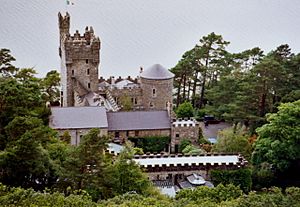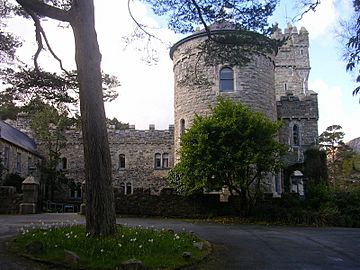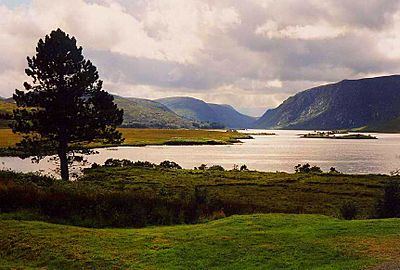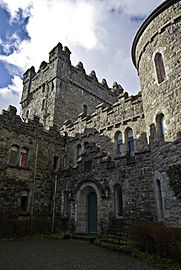Glenveagh Castle facts for kids
Glenveagh Castle (which means Caisleán Ghleann Bheatha in Irish) is a beautiful, large house that looks like a castle. It is located in Glenveagh National Park in County Donegal, Ireland. This special building was finished around 1870.
Contents
History of Glenveagh Castle
Captain John George Adair built Glenveagh Castle between 1867 and 1873. It stands inside the amazing Glenveagh National Park, close to the towns of Churchill and Gweedore in County Donegal, Ireland. The castle is built in a style called Scottish baronial. It has a tall, four-story main tower and is surrounded by lovely gardens. Behind it are huge mountains, lakes, valleys, and forests, covering about 165 square kilometers (40,873 acres). A herd of red deer even lives there! The name Gleann Bheatha means "Glen of the Birch Trees" in Irish.
The park has a visitor center where you can learn all about the area. There are displays and a video show, and it's easy for everyone to visit.
Who Built Glenveagh Castle?
The castle was built by Captain John George Adair (1823–1885). He was from County Laois in Ireland. Adair became very rich by buying and selling land in the United States. He then came back to Ireland and bought a lot of land in Donegal.
In 1869, Adair married Cornelia Wadsworth Ritchie. Her father was a general in the American Civil War. Together, they started creating the castle and its beautiful gardens. Adair wanted his estate to be even grander than Balmoral Castle, which was Queen Victoria's home in Scotland.
Captain Adair is not remembered fondly in Donegal. After a terrible time called the Great Famine, many people were struggling. Adair forced 224 families to leave their homes on his land. He did this not for money, but because he wanted the view from his castle to look better. These events are known as the "Derryveagh Evictions." Many stories and songs remember John George Adair as a very harsh landlord. He bought the land for Glenveagh and Gartan in 1859, making his estate about 28,000 acres (113 square kilometers).
Problems with his tenants started quickly. There were disagreements about hunting rights and sheep grazing on his land. Because of these issues, Adair decided to carry out his threat to evict the tenants. On April 3, 1861, a large group of police and officials arrived to carry out the evictions. The first family to be forced out was a widow, Mrs. Hanna McAward, and her seven children. The evictions continued for three days across many areas. In total, 44 families, or 244 people, lost their homes.
It is said that a curse was placed on the castle because of these unfair evictions. The curse supposedly meant that none of the future owners would have children to inherit the family name.
Many of the evicted people went to the workhouse in Letterkenny. Others received help from local people and church groups who raised money. In Australia, a group called the Donegal Relief Fund helped young people aged 16 to 28 to move there. Many took this chance. As they settled in Sydney, they remembered the difficult stories of their families.
Later Owners of Glenveagh
After John Adair died in 1885, his wife, Cornelia Adair (1837–1921), took over the castle. She lived there part-time and was much more liked than her husband. She made the castle grounds even more beautiful and was kind to the local people. They did not have any children.
In September 1902, the Duke of Connaught and his wife the Duchess visited Mrs. Adair at the castle.
In 1929, Harvard University Professor Arthur Kingsley Porter bought Glenveagh Castle and the land around it from the Adair family. Porter and his wife, Lucy, used it as a second home. They displayed his large art collection there and entertained many guests. Porter also built a small fishing cottage on Inishbofin Island. He mysteriously disappeared from that area on July 8, 1933. Porter's wife, Lucy, later sold the castle and land to Henry Plumer McIlhenny from Philadelphia. McIlhenny was a friend and former student of Porter's at Harvard.
Henry Plumer McIlhenny's Gift
Henry Plumer McIlhenny of Philadelphia bought the estate in 1938. He had been renting it for summer holidays since 1933. In the 1970s, McIlhenny generously gave the gardens and castle to the Irish nation. This allowed Glenveagh National Park to be created. He continued to live in the castle part-time until 1982.
Gallery
See also






